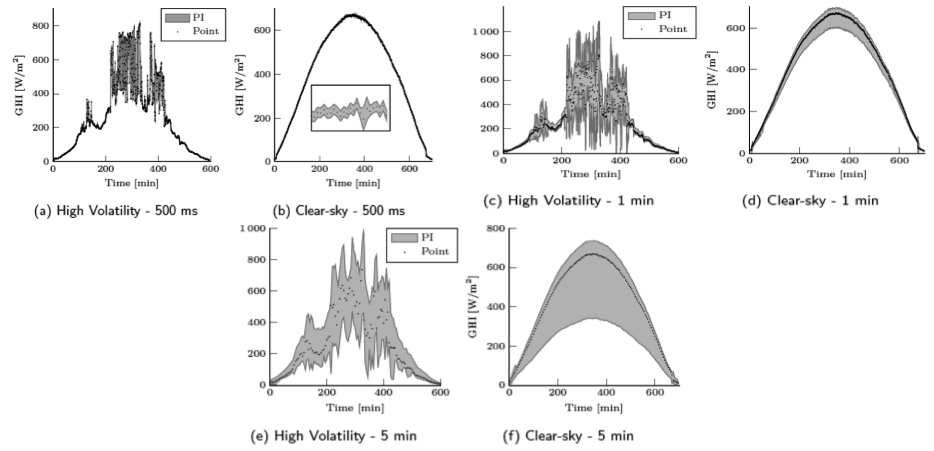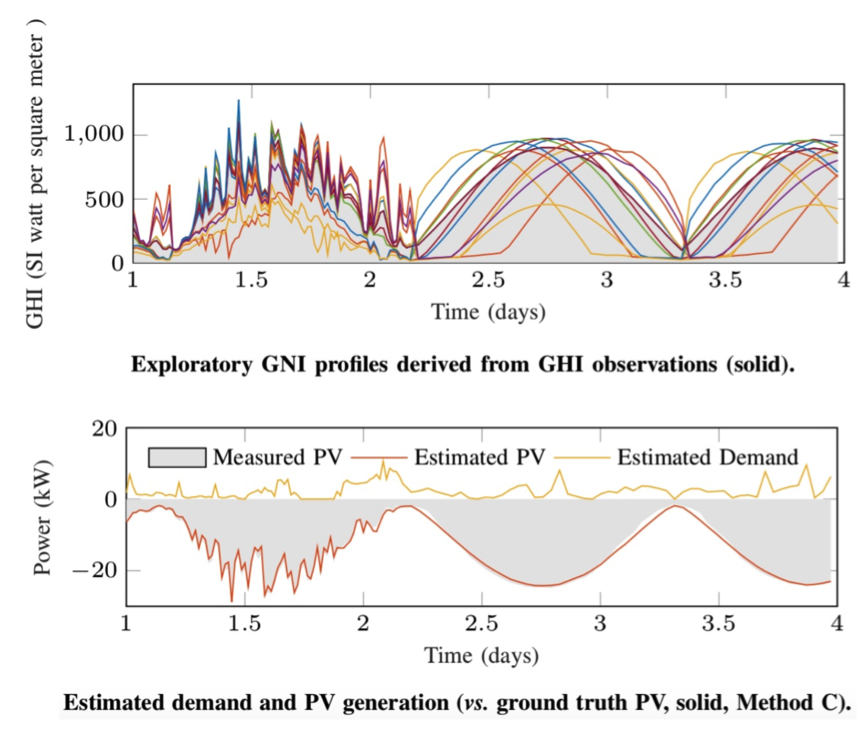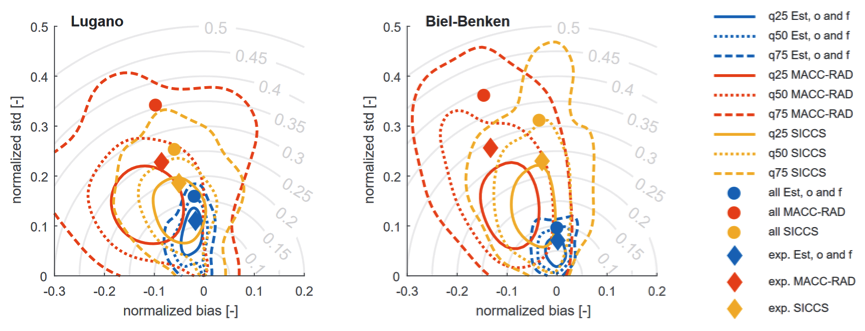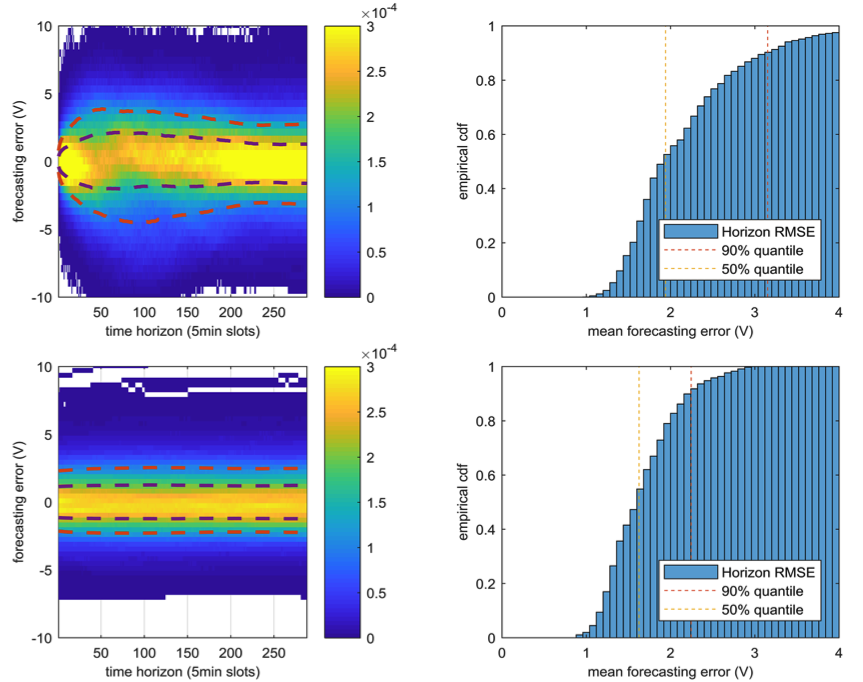Aim
 |
Provide DSOs and power suppliers with advanced control algorithms based on short-term forecasting of PV generation |
Activities
Short-term forecasting of PV generation
A new method for global irradiance forecast was proposed and validated at the EPLF-DESL, focusing on forecast horizons that are meaningful in microgrids control applications (i.e. from sub-second to 30 minutes). The proposed technique extracts information from historical irradiance measurements: data are clustered off-line by using machine-learning algorithms and the quantiles of the obtained clusters are then used for computing the prediction intervals (PIs). The proposed algorithm is evaluated based on performance metrics, namely the PI Coverage Probability (which accounts for the percentage of successful predictions, [%]) and PI Normalized Average width (which represents the width of the PI, normalized with respect to the realization, [%]).
For the identification of clouds position and motion, the information from an all-sky camera is integrated into the algorithm in order to reduce the forecast uncertainty at horizons larger than 5 min and up to 30 min. Color and textures features can be extracted from the ground images to segment the clouds from the clear-sky while comparing consecutive figures allows identifying the cloud motion (direction and velocity).
Besides helping the forecast, the all-sky camera’s usage for the estimation of the irradiance when opportunely calibrated was assessed (Magnone et al., 2017).
Models for prosumers behavior identification
Privacy, conflicts due to ownership of the monitoring infrastructure, and lack of standards for monitoring and communication pose a challenge to operators on how to monitor PV generation efficiently (e.g., for forecasting or control tasks). EPFL-DESL developed an unsupervised algorithm to estimate the total (unobserved) PV generation by using measurements of the power flow at the Point of Common Coupling (PCC) and local Global Horizontal Irradiance (GHI), without information on the installed PV facilities (see Figure 1).
The algorithm was trained with 1 year real-life measurements of GHI and power flow at the PCC and their performance estimated based on PV generation measurements.

Figure 1: Method for real-time estimated PV generation and demand
Improved forecasting methods for DSM strategy
This activity aims to develop novel model-based forecasts for households consumption, exploiting numerical weather forecasts (NWF).
The literature suggests that forecasting accuracy can be improved when the production and consumption in the grid are disaggregated and predicted separately, as this allows to make use of NWF for the prediction of production. Therefore disaggregation methods were designed.
NWF were also used to increase the accuracy of the voltage forecasting of the GridSense devices, by designing new models, for which the required computational power is still low enough to allow them to run on an embedded system.
Preliminary Results
DEVICES
- By mid-January 2018, a first prototype the measurement box with the sensors was ready.
- By end of summer 2018, the measurement boxes and the all-sky camera will be installed at the EPFL PV power plant.
- By end of 2018, both boxes and all-sky camera will be installed at the PV power plant.
METHODOLOGIES
Short-term forecasting of PV generation
The proposed algorithm is shown to outperform alternative methods available in the literature. As shown in Figure 2 the method is able to account for the higher uncertainty (at higher horizons) by adapting the width of the prediction intervals.
The integration of the information from the images is in general beneficial because it leads to narrow the prediction intervals width at horizons larger than 2-5 minutes, while maintaining a high coverage probability.

Figure 2: PIs and realizations are shown for different forecast horizons (500 ms, 1 min and 5 mins). The method is able to guarantee a high coverage (99%) by adapting the width of the prediction intervals.
Furthermore, preliminary results showed that all-sky camera-based local irradiance estimations are more accurate than satellites-based ones. Indeed, thanks to their higher temporal and spatial resolution, all-sky image-based methods can capture the local irradiance dynamics more accurately. These fast dynamics characterize challenging climate conditions such as Switzerland and are responsible for operational issues in power systems.
Finally, physical models of the photovoltaic plants and the converter were developed at the DESL in order to convert the irradiance prediction into a power value (Scolari et al., 2018).
Models for prosumers behavior identification
Best performing methods provide nearly unbiased estimation (i.e. zero mean) with root-mean-square values of the estimation error in the ranges 4-7% without PV self-consumption and 6-10 % with self-consumption. Worse performance is due to masked PV generation patterns (see Figure 3).

Figure 3: Estimated demand and PV generation (vs. Ground truth PV, solid)
Improved forecasting methods for DSM strategy
An unsupervised disaggregation method based on GHI measurements was developed in collaboration between EPFL-DESL and SUPSI-ISAAC. It is used to detect the presence of PV installation and to obtain their physical model. This allows the use of a numerical weather prediction service to better estimate PV power production in the next 24 hours. An example of disaggregated power profile is shown in Figure 4. The work was published on IEEE Transaction on Industrial Informatics (Sossan and al, 2018).

Figure 4: Input, intermediate results and output of the proposed disaggregation
As a local measurement of GHI is not always available, a novel algorithm for the estimation of GHI from PV AC power measurements was developed. This avoids the need of a locally installed pyranometer, widening the adoption of the methodology. In Figure 5, the accuracy of the method is compared with other two satellite-based irradiance estimation methods, in terms of bias, standard deviation and root mean squared error. The work was published on Solar Energy (Nespoli et al, 2017).

Figure 5: Normalized bias and standard deviation of the MACC-RAD and SICCS services and the proposed method (using outlier detection and trust function), for the two test sites. Colored lines are estimated regions containing 25, 50 and 75 % of the observations, when considering daily subsets. Filled circles represent normalized squared bias and normalized standard deviation for the whole datasets, while diamonds represent the expected daily normalized squared bias and normalized standard deviation. Grey lines show contour lines for the normalized RMSE.
The new Gridsense voltage forecasting algorithms are based on a two-season addictive Holt-Winter exponential smoothing, detrended by taking NWF into account. We assumed a linear dependence of voltage from external temperature and irradiance and we estimated it using an online least-square regression, which does not require keeping the entire history of variables in memory. The voltage forecasting resulted in a lower forecasting error and therefore higher performances of the energy management algorithms. The improvement of the forecasts compared with the one from the old algorithm is shown in Figure 6.

Figure 6: Old (top) vs new forecasting method (bottom) for 24 hours voltage prediction
Involved partners/Contacts
 |
Forecasting for grid applications: |
 |
Forecasting for DSM: |
References
Magnone, L., Sossan, F., Scolari, E., and Paolone, M. (2017) Cloud Motion Identification Algorithms Based on All-Sky Images to Support Solar Irradiance Forecast. In: Photovoltaic Specialists Conference. 2017. https://infoscience.epfl.ch/record/228953?ln=en
Nespoli, L. and Medici, V. (2017) An unsupervised method for estimating the global horizontal irradiance from photovoltaic power measurements. Solar Energy. https://arxiv.org/abs/1706.06878
Scolari, E., Reyes, L., Sossan, F., and Paolone. M. (2017). A Comprehensive Assessment of the Short-Term Uncertainty of Grid-Connected PV Systems, in IEEE Transactions on Sustainable Energy, vol. PP, no.99,pp1-1. https://infoscience.epfl.ch/record/233691?ln=en
Sossan, F., Nespoli, L., Medici, V., and Paolone, M. (2018). Unsupervised Disaggregation of PhotoVoltaic Production from Composite Power Flow Measurements of Heterogeneous Prosumers. IEEE Transactions on Industrial Informatics, https://infoscience.epfl.ch/record/233810?ln=en